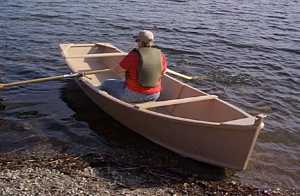
| Home | |
| Q7 Rowboat |


|
| Boat has now been built |
| Please note that I now have built a newer pair of oars, with smaller diameter handrgrips, and large weights made of wood inboard of the rowlocks for oar balance. This is a photo of my earlier pair of oars |
| Please note that this is the axle system I am using now, however I have upgraded to a solid steel 16mm diameter axle, as the hollow aluminium axle was not strong enough. The axle stays on the boat at all times, in the water, manhandling the boat around and whilst cartopping |
|
Details of the New Boat as Built
Overview of this boat After quite a lot of time with this boat, I can say that I am very happy with it. If is fast through the water, very seaworthy, low windage and has good ergonomics. Possibly could do with a fraction more beam in the bottom panel (3cm or so), a bit lighter would be a plus too. A removable center thwart would be a plus, so I could sleep in it more easily, versus the fixed thwart I have now. All in all though it is a very very good boat. |
|
Overview - old notes written before the boat was built As of 27 November 2011, these are the new lines for my next boat. In short it is a 13ft x 4ft rowboat. Note that I had worked on the lines for quite some time, making small changes here, small changed there. Based on my previous lines I have deepened the forefoot to a degree, made the bow more full to a degree, and also increased the beam It is hard to know how these changes will work out in practice. A rowboat is compromise between many competing factors, for example a narrower beam might give better performance in very rough conditions, as happens with a dory, but at the expense of the boat being less welcoming for those less used to small boats. If the boat is too tender, then although the boat may have excellent rough water capabilities, if people are not confident in using it, then if will not be used. A finer bow may create a faster boat, yet a more full bow will rise up into a heavy sea, and in so doing keep the water out. So the degree of fineness is a compromise between these two competing factors. Main features of this boat when compared to my previous 18ft dory are
The older sketches of this rowboat can be seen HERE
Specifications for this boat are as follows
Note I have now written up a list of 500 different rowboats for those wanting to compare rowboats, see this LINK |
|
Other boats that are very similar
|
| What these boats look like
QT Skiff
Whisp Rowboat
R13 Rowboat
Seagull Rowboat
Flint 14 Rowboat Sucher dory - note transom is heavily sloped aft
Deben 400 Rowboat
Weymiss Skiff
Shenandoah Whitehall Rowboat
Joansa Rowboat
Echo Bay Dory Skiff |
|
Below can be seen the excellent Spur II rowboat by Phil Bolger. An extremely capable boat, I have shown it as an example of how a rowboat that has rough water capabilities, has a bow that fills out very quickly |
 |
| Home |









